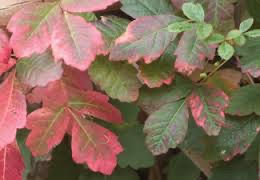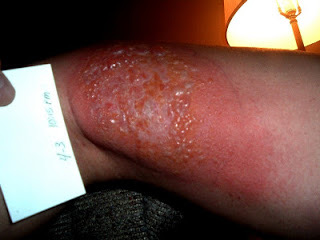Poison Oak

As the weather heats up and people are hiking and walking animals outdoors, we physicians start seeing the results of a contact dermatitis known as poison oak or poison ivy. Some of the tell-tell signs for diagnosing this condition is the severe itching, patchy redness that is in certain skin areas only and also notice the linear streak on the top back area of her neck. That is a classic rhus dermatitis (poison oak) appearance as are clusters of fluid filled blisters.

Poison Oak is a leafy shrub that grows wild on the West coast. Poison Ivy grows on the East coast as does Poison Sumac. It commonly grows like an ivy vine and as summer rolls on the pointed leaves turn orange color.
The rash is caused by a toxic substance in the plant called urushiol. Brushing against it or touching an object that has brushed against it (dog fur, shoe laces, backpacks, clothing, hats) can cause an extreme allergic reaction. Like any allergic response, the symptoms get worse with each successive contact and some people are naturally more sensitive.
The insanely itchy rash appears 8-48 hours after contact with the plant but a first time contact can take up to 15 days for a reaction.
Many people with poison oak rash think they are spreading it by scratching because it keeps progressing over days to weeks with new areas of rash. It is not spread by scratching or touching the skin. The body is mounting an extreme antibody reaction to the poison and the areas of rash are increasing from the immune response...not from touching it.
The best treatment is avoidance. Once you have suffered from poison oak/ivy rash, you learn how to be proactive. But if you do contact it and suffer severe cases on the face, genitals or large parts of the body, it can be treated with corticosteroid medication to block the immune response. Small areas may respond to steroid creams, antihistamines and cool baths. Large areas may require an injection or pills.
And never burn poison ivy or poison oak to get rid of it. The smoke can carry the resin and cause severe inhalation reaction.






Commenti